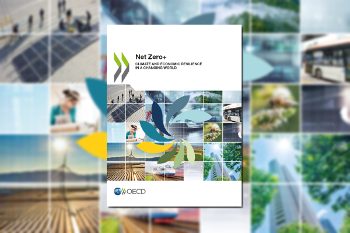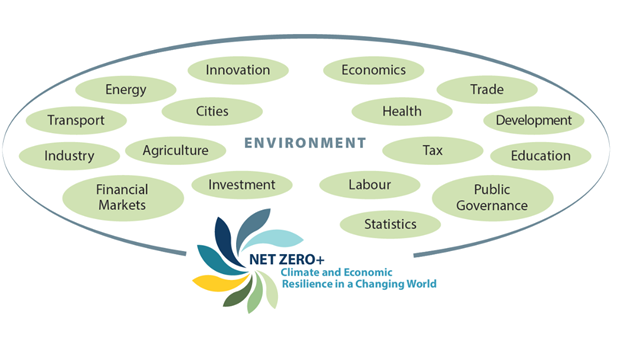Environment Focus
An environmental lens on policies for better lives
Accelerating climate action: 12 steps for governments to build climate and economic resilience
By Kilian Raiser, OECD Environment Directorate

Action on climate change has never been more urgent. With current levels of global warming, scientists warn that some catastrophic climate system ‘tipping points’ are already dangerously close to being triggered. Governments and society must act fast to reduce emissions and adapt to already “baked in” climate impacts. Yet countries remain far off track in implementing climate policies at the necessary scale and speed.
Climate action does not happen in a vacuum, isolated from the world’s other equally-urgent policy priorities. Climate policies need to go beyond the sole aim to reduce emissions, and must also aim to be cost-effective, fair and equitable, politically tenable, compatible with health, social and fiscal policy and aligned with foreign policy concerns. Above all, they need to be resilient in the face of future disruptions.
Facing the unknown: Climate policies must consider future disruptions
Events over the past few years have hammered this point home. The COVID-19 pandemic and Russia’s war of aggression against Ukraine have demonstrated the climate-related opportunities a crisis can bring, such as immense economic recovery spending and capacity for dramatic societal transformations within short time periods as witnessed during COVID lockdowns and through energy-saving behaviour during the recent energy crisis. They also bring climate-related challenges to light – misaligned recovery spending, locked-in fossil fuel use, and the disruptive effects of geopolitical tensions. The immense scale and speed of the transformation necessary to reach net zero will have profound implications on public revenues, economic structures and labour markets. If left unaddressed, these aspects could undermine and even derail climate policy ambition. In addition, potential future disruptions, such as the rapidly increasing use and capabilities of artificial intelligence, must be considered in the development of climate policies.
Net Zero+, an OECD cross-cutting initiative
The OECD’s flagship initiative “Building Climate and Economic Resilience: Net Zero+” outlines a series of recommendations for a resilient transition to net-zero emissions while building resilience to the impacts of climate change itself. The initiative collates climate-relevant findings from across the OECD’s multidisciplinary expertise – for example on environment, economic and tax policy, financial and fiscal affairs, development, science and technology, and employment and social affairs – to provide cohesive recommendations for making the transition to net zero emissions resilient, and as well as building resilience to the impacts of climate change.
Figure: Net Zero+: Climate-relevant policy expertise from across the OECD

12 steps for better climate policies
Drawing on a wide range of policy expertise across the OECD, in its first phase, the Net Zero+ initiative collated insights to develop 12 concrete steps for governments to build climate and economic resilience:
- Given the increasing threat of reaching climate system tipping points, do everything possible to limit global warming to 1.5°C with no overshoot. Faster reductions are essential and the shape of the pathway matters. The most up-to-date evidence shows that we are already entering the warming range at which some potentially catastrophic impacts become possible. Every fraction of a degree of warming makes a difference.
- Ensure that crisis relief and economic stimulus spending are aligned with climate goals and sufficiently targeted. The massive amounts spent on crisis relief and economic recovery over the past few years were an opportunity to accelerate climate action, but more could have been done. We must do better to seize the climate-related opportunities that may come with future disruptions.
- “Future-proof” net-zero climate strategies to the extent possible, using strategic foresight and anticipating transition bottlenecks. Some obstacles are already clear – such as the cost of capital, critical materials supply, and re- and up-skilling needed for the transition. Foresight processes can tease out other bottlenecks and possible future disruptions, and develop forward-looking strategies to deal with them.
- Focus policy making on a systems level rather than individual components or outcomes. Systemic resilience implies anticipating future shocks, building in buffers to absorb initial impacts, and ensuring that resources are available to invest in recovery efforts. Some changes may be irreversible and require permanent adaptation to new circumstances.
- Get climate policy basics right, tailoring a mix of price-based and other instruments to regional, national and local circumstances, and greening of public governance. Resilient climate policies must be effective and appropriate to their context. There are no silver bullets here: governments have a wide range of climate policy tools at their disposal and should make use of all of them.
- Mainstream climate change adaptation throughout national policy processes. Exploit synergies between mitigation and adaptation policy objectives while minimising trade-offs. It’s time to get serious about mainstreaming adaptation into core policy thinking. Governments are already facing escalating costs from climate damages and climate impacts will continue to mount even if the most ambitious emissions reductions are achieved. Climate mitigation and adaptation actions should be leveraged in ways that simultaneously support both sets of policy objectives, for example through nature-based solutions.
- Address the public finance implications of the net-zero transition through careful fiscal planning, assessing direct and indirect effects of policies, and climate-aligned tax instruments. Existing taxes on fossil fuels generate significant government revenues. Reaching net zero means these and others will be lost as economic structures shift. The OECD’s modelling of the public finance implications of the net-zero transition shows widely heterogeneous effects across countries and time periods. Careful fiscal planning is essential.
- Accelerate innovation through a mission-oriented, outcome-based approach. Target support measures for early-stage innovation and R&D. Innovation is essential to bring down the costs of emissions reductions and to reach hard-to-abate sectors. Current policy portfolios put too much focus on deployment and not enough on research and development.
- Carefully assess direct and indirect distributional impacts of climate policy. Communicate clear, accurate and easily accessible information to the public about how policies work. Managing the economic effects of climate policies on people is essential. As one example of how to do so, revenue from carbon pricing can be recycled to balance distributional impacts. To ensure that the net-zero transition is publicly supported, governments must clearly communicate not only why policies are needed, but how they will be implemented and what impacts they may have on households.
- Ensure reasonable labour market flexibility and mobility while promoting job quality and protecting workers. Identify skills needs and bottlenecks and prioritise up- or re-skilling. The net-zero transition will cause some jobs to be lost, but new jobs will emerge. Helping workers shift between sectors, and ensuring they have the skills needed, is integral to an effective, fair and equitable transition.
- Better align financial system policies with climate mitigation and adaptation goals, including improved market practices, alignment of core investment policies, use of responsible business conduct tools, and harnessing the double role of the insurance sector as investor and insurance provider. Reaching net zero will require vast amounts of investment. There will be numerous economic opportunities, but financial markets and the private sector cannot rely on public spending to unlock these.
- Recognise the interlinkages between climate and development transitions, drawing on all levers of development co-operation to converge on a ‘global approach’ that aligns development and climate objectives. We need to reach net zero globally. Developing countries are both the source of the majority of future emissions and most exposed to future impacts of climate change. Their needs and perspectives must be given equal consideration.
Each of these recommendations is expanded upon in the project’s Phase I synthesis report, Net Zero+: Climate and Economic Resilience in a Changing World. This is not a pick-and-mix list, however. All of these steps are indispensable. Recent global crises, and those to come, are an opportunity for governments to prioritise building climate and economic resilience – one that should not be missed.
Further reading
Report: Climate Tipping Points: Insights for Effective Policy Action
The OECD International Programme for Action on Climate (IPAC)

The system dynamics approach of Earth4All (Club of Rome) shows the negative effects of feedback loops in the system, and thus recommends fighting poverty and inequality first, before digging into climate policies incl clean water and safe food. Why does the OECD dismiss this approach? Will these recommendations work when countries are faced with persistent poverty and inequality?
LikeLike
Your comment makes a very good point – climate policies are not enacted in a vacuum or in isolation of other pressing socio-economic priorities, including tackling poverty and inequality, food security and quality, water, etc. Indeed, steps 9, 10 and 12 speak to the need to make climate policies fair and equitable and align them with development needs, which would include the priorities you mention. However, rather than putting one step before another, we need to integrate these concerns within climate policy making (hence our call for a systemic approach) and make sure that the transformation to net zero leaves people better off. We agree that resilience also means tackling inequality and poverty and that these should not be overlooked due to climate priorities.
LikeLike